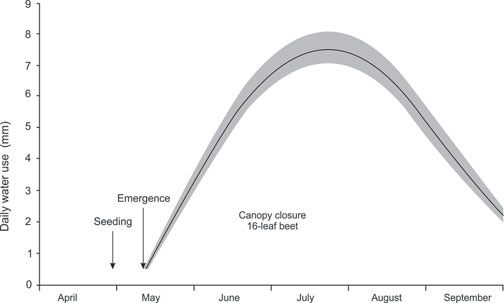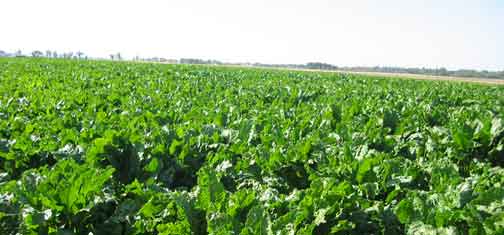| | Irrigation management | Strategies | Sugar beet water needs | Irrigation scheduling strategy | Soil texture | Conclusion
Irrigation management is about controlling the rate, amount, and timing of applied irrigation water in a planned and efficient manner. With the best irrigation management practices, a sugar beet crop can achieve high root and sugar yield potential.
Irrigation Management
The goal of irrigation management is to use available irrigation water effectively in managing and controlling the soil moisture environment of crops to do three things: promote the desired crop response, minimize soil degradation, and protect water quality.
Proper irrigation management requires a good understanding of a number of factors:
- soil fertility (crop nutritional requirements)
- soil-water-plant relationships
- crop type
- crop sensitivity to water stress
- crop growth stages
- availability of a water supply
- climatic factors that affect crop water use such as rainfall, temperature, humidity, and net radiation
- irrigation system capabilities and limitations
Equipped with such knowledge, an irrigator can develop a workable and efficient irrigation scheduling program.
Strategies
A workable and efficient irrigation management strategy should be crop-specific. Crop-specific irrigation management strategies mean available water is used efficiently to meet a specific crop’s water requirements for maximum water productivity.
Generally, the goal is to ensure that water is available at germination and in early development by applying light, frequent irrigations (if there is no rainfall). This method promotes vigorous growth and replenishes and increases available soil water content in the entire root zone during the early growth stages. Such a strategy will allow modern pivot irrigation systems to keep up to crop demand during the peak water use period, which typically occurs during the taproot enlargement growth stage.
Crop-specific irrigation management strategies are usually applied to adjust for the following differences among crops:
- effective root zones
- sensitivity to water stress
- types (cool versus warm-season)
- vulnerability to diseases at various crop growth stages
- response to soil fertility levels
- plant population/densities
- physiologic maturity (timing of last irrigation)
- potential income
Sugar Beet Water Needs
Sugar beet uses water for growth and cooling purposes. The water requirement or evapotranspiration (ET) for sugar beet depends on variety, growth stage, canopy density, climatic conditions, and irrigation and crop management.
Sugar beet grown under optimal conditions (well-fertilized, well-irrigated, well-drained soils, pest-free stand, and uniform and optimum canopy) requires about 500 mm of water per growing season in southern Alberta.
Typically, sugar beet roots grow to an effective water extraction depth of 100 cm. Root distribution is concentrated near the soil surface; hence, a beet plant obtains 70 per cent of its seasonal water from the upper 50 cm of the active root zone. The active root zone changes from a few millimetres at emergence to a maximum depth of 100 cm at the full canopy closure and root enlargement growth stages.
Average sugar beet water use ranges from about 0.1 mm per day when the crop emerges to nearly 8 mm per day when the crop canopy completely shades the ground and the tap root is enlarging (Figure 1). Sugar beet water demand decreases as the old leaves start to die and temperatures start to cool down in the fall.

Figure 1. Daily water use during different growth stages of irrigated sugar beet in southern Alberta. Shaded area indicates variation in sugar beet water use depending on cultivar and climatic conditions.
Irrigation Scheduling Strategy
Effective sugar beet irrigation scheduling uses soil water levels in the root zone as a measure for starting and stopping irrigations. Adequate soil water is critical for sugar beet during emergence and early growth stages. Therefore, it is best to have a seedbed (0 to 50-cm depth) that is near 80 per cent of available soil water at planting
Sugar beet has small seeds that need to be planted at a shallow depth (2.5 cm), which can leave seedlings susceptible to inadequate surface soil moisture. The crop requires water for germination and root development during the early stages of growth.
If sugar beet is seeded in a dry seedbed (less than 60 per cent of available in the 0 to 50-cm depth) in late April before irrigation water is available, the first and subsequent irrigations (15 mm per irrigation event) should be applied as soon as irrigation water is available in early May. These irrigations should be light and frequent to maintain a moist soil surface, prevent crusting, and encourage rapid emergence and early root development.
Sugar beet will reach canopy closure early if soil water in the 0 to 50-cm depth is maintained at greater than 60 per cent of available. Irrigation water applied before complete canopy closure (16-leaf growth stage) should meet crop water requirements and build up soil water to near field capacity in the 50 to 100-cm depth for later crop use during the peak water demand period. Sugar beet peak water use occurs during a 30-day period in July. (Figure 1).
Sugar beet reaches maximum extension at the full canopy closure growth stage (Figure 2). To ensure that soil water is adequate throughout the entire active root zone, the monitoring depth for irrigation scheduling purposes should be increased from 50 cm to 100 cm, and soil water should not be depleted to less than 60 per cent of available (i.e. allowable depletion should not be greater than 40 per cent of available).

Figure 2. A well-irrigated sugar beet crop (variety: Beta BTS 43RR90) near Lethbridge, Alberta, on August 12, 2009.
Increasing the irrigation management root zone from 50 cm to 100 cm at full canopy closure requires less frequent and larger irrigation volumes and results in increased water availability to the mature and enlarging sugar beet roots.
In general, any irrigation applied during the growing season should start when available soil water is near 65 per cent to prevent the available soil water from being depleted to less than 60 per cent. Every irrigation application should also supply sufficient water to replace the water used by the crop as well as to accommodate losses within the irrigation system.
Some irrigation water may be applied just prior to harvesting to maintain soil moisture slightly above 60 per cent of available for ease of digging.
Soil Texture
The irrigation amounts required to replenish the root zone once the allowable soil water depletion level is reached will vary with soil texture and growth stage (Table 1).
Table 1. Soil texture-based estimation of total available water and water amounts per irrigation event for sugar beet during early and peak developmental stages
| Soil texture | 50-cm root zone
(Early sugar beet growth) | 100-cm root zone
(Peak sugar beet growth) |
 | Total available water
(mm) | Water required to replenish soil to field capacity at 40% allowable depletion | Total available water
(mm) | Water required to replenish soil to field capacity at 40%
allowable depletion |
| Loamy sand | 57 | 23 | 114 | 46 |
| Sandy loam | 70 | 28 | 140 | 56 |
| Loam | 90 | 36 | 180 | 72 |
| Sandy clay loam | 76 | 28 | 152 | 61 |
| Silt loam | 100 | 40 | 200 | 80 |
| Clay loam | 100 | 40 | 200 | 80 |
| Silty clay loam | 110 | 44 | 220 | 88 |
| Sandy clay | 86 | 34 | 172 | 69 |
| Silty clay | 106 | 42 | 212 | 85 |
| Clay | 96 | 38 | 192 | 77 |
Conclusion
Using suitable irrigation strategies with sugar beet can mean a healthy crop with high yield and quality potential. In addition to ensuring that the sugar beet crop is well-fertilized and well-protected from pests, growers are encouraged to properly manage irrigation by regularly monitoring soil water to ensure that the availability of water does not become a limiting factor in producing a high yielding sugar beet crop.
Applying irrigation just before the available soil water is depleted to 60 per cent and replenishing available soil water near field capacity in appropriate root zones will greatly assist in producing a high quality and high yielding sugar beet crop.
Prepared by
Alberta Agriculture and Forestry
For more information, contact
Alberta Ag-Info Centre
Call toll-free 310-FARM (3276)
Source: Agdex 171/561-1.Revised February 2012.
|
|